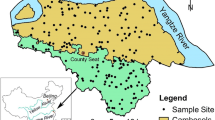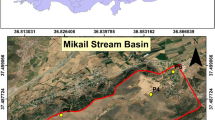Abstract
Purpose
The establishment of geochemical baselines is essential for accurate evaluation of the present state of surface environments. In this study, normalization procedures (NP), which can improve the explanation of the natural variation of elements, were conducted using geochemical common factors (GCF) and soil organic matter (SOM) as normalizers to define the geochemical baselines of soil trace elements.
Materials and methods
Soil samples (n = 345) were collected in Luhe County, Jiangsu, China, a county with a complex geologic setting and intensive anthropogenic influence. Conservative elements, Al, Ca, Fe, K, Mg, Mn, Na, P, and Ti; trace elements, As, Cd, Cr, Cu, Hg, Ni, Pb, and Zn; and SOM were measured. Normalization procedures were conducted using multiple linear regressions between soil trace elements and SOM and GCFs, acquired from factor analysis of the soil major elements. Normalization procedures using univariate linear regressions between soil trace elements and conservative elements Al, Fe, and Ti were also conducted for comparison.
Results and discussion
Comparison of NPs using GCFs and SOM as normalizers with NPs, which use single conservative elements as normalizers, shows that the former is more accurate than the latter for As, Pb, and Zn and is as accurate for Cd, Cr, Cu, Hg, and Ni, when the most appropriate single conservative element is chosen. Small-scale geochemical baselines in the county are significantly different from regional-scale geochemical baselines for Jiangsu Province, China.
Conclusions
The application of regional-scale geochemical baselines at small scales may lead to estimation errors in determining anomalies and assessing environments. Baselines obtained from the NPs using GCFs and SOM as normalizers are more accurate.




Similar content being viewed by others
Abbreviations
- CV:
-
Coefficient of variation
- GCF:
-
Geochemical common factor
- JRGB:
-
Jiangsu regional geochemical baselines
- NP:
-
Normalization procedure
- SD:
-
Standard deviation
- SOM:
-
Soil organic matter
References
Bech J, Tume P, Longan L, Reverter F, Bech J, Tume L, Tempio M (2008) Concentration of Cd, Cu, Pb, Zn, Al, and Fe in soils of Manresa, NE Spain. Environ Monit Assess 145:257–266
Changchun Institute of Geography, Chinese Academy of Sciences (1998) Atlas of study on background value of aquatic environment of the Changjiang River Valley. Science, Beijing (in Chinese)
Chen JS, Wang FY, Li XD, Song JJ (2000) Geographical variations of trace elements in sediments of the major rivers in eastern China. Environ Geol 39:1334–1340
China Geological Survey (2004) Geological map of China (1:2, 500, 000). China Geological Map, Beijing (in Chinese)
Covelli S, Fontolan G (1997) Application of a normalization procedure in determining regional geochemical baselines. Environ Geol 30:34–45
Crommentuijn T, Sijm D, de Bruijn J, van den Hoop M, van Leeuwen K, van de Plassche E (2000) Maximum permissible and negligible concentrations for metals and metalloids in The Netherlands, taking into account background concentrations. J Environ Manage 60:121–143
Darnley AG (1997) A global geochemical reference network: the foundation for geochemical baseline. J Geochem Explor 60:1–5
Daskalakis KD, O'Connor TP (1995) Normalization and elemental sediment contamination in the coastal United States. Environ Sci Technol 29:470–477
de Groot A, Zshuppe K, Salomons W (1982) Standardization of methods of analysis for heavy metals in sediments. Hydrobiologia 92:531–536
Donazzolo R, Hieke MO, Menegazzo VL, Orio AA, Pavoni B, Perin G, Rabitti S (1981) Heavy metal contamination in surface sediments from the Gulf of Venice, Italy. Mar Pollut Bull 12:417–425
Donoghue JF, Ragland PC, Chen ZQ, Trimble CA (1998) Standardization of metal concentrations in sediments using regression residuals: an example from a large lake in Florida, USA. Environ Geol 36:65–76
Environmental Monitoring Station of China (1990) The geochemical background of Chinese soil elements. China Environmental Science, Beijing (in Chinese)
Fergusson JE (1990) The heavy elements: chemistry, environmental impact and health effects. Pergamon, Oxford
Galuszka A (2007) A review of geochemical background concepts and an example using data from Poland. Environ Geol 52:861–870
Horckmans L, Swennen R, Deckers J, Maquil R (2005) Local background concentrations of trace elements in soils: a case study in the Grand Duchy of Luxembourg. Catena 59:279–304
Kabata-Pendias A (2001) Trace elements in soils and plants. CRC, Boca Raton
Kersten M, Smedes F (2002) Normalization procedures for sediment contaminants in spatial and temporal trend monitoring. J Environ Monit 4:109–115
Lee L, Helsel D (2005) Baseline models of trace elements in major aquifers of the United States. Appl Geochem 20:1560–1570
Liu TS (1985) Loess and the environment. Ocean, Beijing
Liu M, Fan DJ (2009) Comparison of the element compositions between the sediments entered into the seas from the Changjiang and the Huanghe Rivers. Adv Mar Sci 27:42–50 (in Chinese)
Loring DH (1978) Geochemistry of zinc, copper and lead in the sediments of the estuary and Gulf of St. Lawrence. Can J Earth Sci 15:757–772
Loring DH (1990) Lithium—a new approach for the granulometric normalization of trace metal data. Mar Chem 29:155–168
Loring DH, Rantala RTT (1992) Manual for the geochemical analyses of marine sediments and suspended particulate matter. Earth Sci Rev 32:235–283
Lu RK (ed) (1999) Analysis method of soil and agricultural chemistry. China Agricultural Science & Technology, Beijing (in Chinese)
Matschullat J, Ottenstein R, Reimann C (2000) Geochemical baseline—can we calculate it? Environ Geol 39:990–1000
Nelson DW, Sommers LE (1996) Total carbon, organic carbon, and organic matter. In: Sparks DL (ed) Methods of soil analysis, part 3, chemical methods—SSSA book series no. 5. SSSA, Madison, pp 961–1010
Office of Soil Survey in Luhe County (1985) The Soils of Luhe County, Jiangsu Province. Office of Soil Survey in Luhe County, Jiangsu (in Chinese)
Pilotte JO, Winchester JW, Glassen RC (1978) Detection of heavy metal pollution in estuarine sediments. Water Air Soil Pollut 9:363–368
Provincial Fundamental Geomatics Centre of Jiangsu (2004) Atlas of Jiangsu Province. SinoMaps, Beijing (in Chinese)
Reimann C, Filzmoser P, Garrett RG (2005) Background and threshold: critical comparison of methods of determination. Sci Total Environ 346:1–16
Salminen R, Tarvainen T, Demetriades A, Duris M, Fordyce FM, Gregorauskiene V, Kahelin H, Kivisilla J, Klaver G, Klein H, Larson JO, Lis J, Locutura J, Marsina K, Mjartanova H, Mouvet C, O’Connor P, Odor L, Ottonello G, Paukola T, Plant JA, Reimann C, Schermann O, Siewers U, Steenfelt A, Van der Sluys J, de Vivo B, Williams L (1998) FOREGS geochemical mapping. Field manual. Geologian tutkimuskeskus, Opas—Geological Survey of Finland, Guide 47
Schiff K, Weisberg SB (1999) Iron as a reference element for determining trace metal enrichment in California coastal shelf sediments. Mar Environ Res 48:68–77
Sierra M, Martínez FJ, Aguilar J (2007) Baselines for trace elements and evaluation of environmental risk in soils of Almería (SE Spain). Geoderma 139:209–219
Teng YG, Ni SJ, Tuo XG, Zhang CJ, Ma XY (2002) Geochemical baseline and trace metal pollution of soil in Panzhihua mining area. Chin J Geochem 21:274–281
Teng GY, Ni SJ, Wang JS, Niu LG (2009) Geochemical baseline of trace elements in the sediment in Dexing area, South China. Environ Geol 57:1649–1660
Vadyunina AG, Korchagina ZA (1986) Methods for studying of soil physical properties. Agropromizdat, Moscow
Wedepohl KH (1978) Handbook of geochemistry. Springer, Berlin
Windom HL, Schropp SJ, Calder FD, Ryan JD, Smith RG, Burney LC, Lewis FG, Rawllnsont CH (1989) Natural trace metal concentrations in estuarine and coastal marine sediments of the southeastern United States. Environ Sci Technol 23:314–320
Yang SY, Li CX (1999) Characteristic element compositions of the Yangtze and the Yellow River sediments and their geological background. Mar Geol Quatern Geol 19:19–26 (in Chinese)
Yang SY, Li CX, Jung HS, Lee HJ (2002) Discrimination of geochemical compositions between the Changjiang and the Huanghe sediments and its application for the identification of sediment source in the Jiangsu coastal plain, China. Marine 186:229–241
Yang SY, Jung HS, Li CX (2004) Two unique weathering regimes in the Changjiang and Huanghe drainage basins: geochemical evidence from river sediments. Sediment Geol 164:19–34
Zhang J, Huang WW, Wang Q (1990) Concentration and partitioning of particulate trace metals in the Changjiang (Yangtze River). Water Air Soil Poll 52:57–70
Zhang HB, Luo YM, Wong MH, Zhao QG, Zhang GL (2007) Defining the geochemical baseline: a case of Hong Kang soils. Environ Geol 52:843–851
Zheng HL, Chen J, Deng WJ, Tan MZ (2005) Assessment of soil heavy metals pollution in the chemical industrial areas of Nanjing peri-urban zone. Acta Scientiae Circumstantiae 25:1182–1188 (in Chinese)
Zhi XC (1991) Trace element geochemistry of Tertiary continental alkalic basalt from Liuhe-Yizheng, Jiangsu Province, China. Chin J Geochem 10:204–216
Zou HB, Zindler A, Xu XS, Qi Q (2000) Major, trace element, and Nd, Sr and Pb isotope studies of Cenozoic basalts in SE China: mantle sources, regional variations, and tectonic significance. Chem Geol 171:33–47
Acknowledgments
Funding is provided by the Natural Science Foundation of China (40601039), Natural Science Foundation of Jiangsu Province (BK2009340), and the Knowledge Innovation Program of the Chinese Academy of Sciences (KZCX2-YW-409).
Author information
Authors and Affiliations
Corresponding author
Additional information
Responsible editor: Chris Johnson
Rights and permissions
About this article
Cite this article
Wang, Z., Darilek, J.L., Zhao, Y. et al. Defining soil geochemical baselines at small scales using geochemical common factors and soil organic matter as normalizers. J Soils Sediments 11, 3–14 (2011). https://doi.org/10.1007/s11368-010-0269-4
Received:
Accepted:
Published:
Issue Date:
DOI: https://doi.org/10.1007/s11368-010-0269-4




